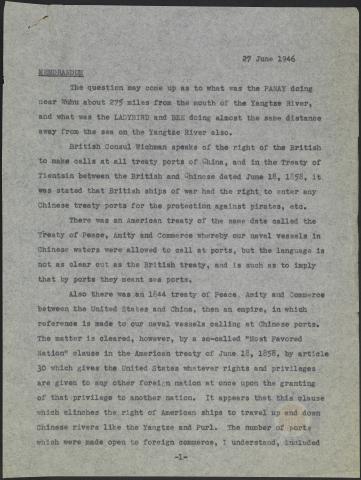
Page 1
| Parent | Why PANAY, LADYBIRD, BEE ships were near Yangtze River |
|---|---|
| Date | 27 June 1946 |
| Language | English |
| Collection | Tavenner Papers & IMTFE Official Records |
| Box | Box 3 |
| Folder | General Reports and Memoranda from June 1946 |
| Repository | University of Virginia Law Library |
27 June 1946
MEMORANDUM
The question may come up as to what was the PANAY doing near Wuhu about 275 miles from the mouth of the Yangtze River, and what was the LADYBIRD and BEE doing almost the same distance away from the sea on the Yangtze River also.
British Consul Wichman speaks of the right of the British to make calls at all treaty ports of China, and in the Treaty of Tientsin between the British and Chinese dated June 18, 1858, it was stated that British ships of war had the right to enter any Chinese treaty ports for the protection against pirates, etc.
There was an American treaty of the same date called the Treaty of Peace, Amity and Commerce whereby our naval vessels in Chinese waters were allowed to call at ports, but the language is not as clear cut as the British treaty, and is such as to imply that by ports they meant sea ports.
Also there was an 1844 treat of Peace, Amity and Commerce between the United States and China, then an empire, in which reference is made to our naval vessels calling at Chinese ports. The matter is cleared, however, by a so-called “Most Favored Nation” clause in the American treaty of June 18, 1858, by article 30 which gives the United States whatever rights and privileges are given to any other foreign nation at once upon the granting of that privilege to another nation. It appears that this clause which clinches the right of American ships to travel up and down Chinese rivers like the Yangtze and Purl. The number of ports which were made open to foreign commerce, I understand, included
-1-
